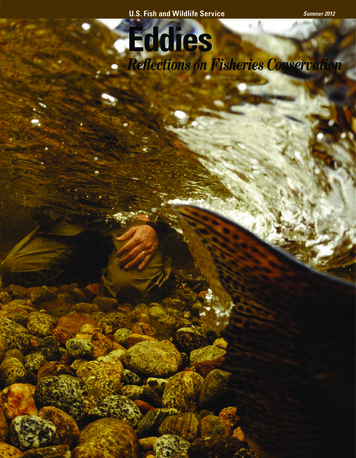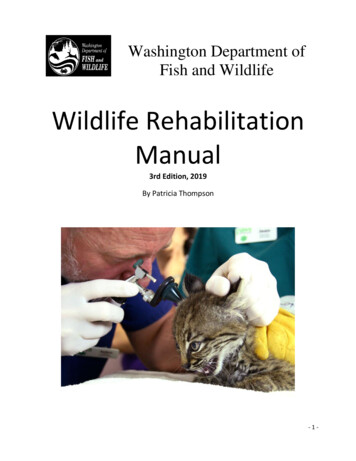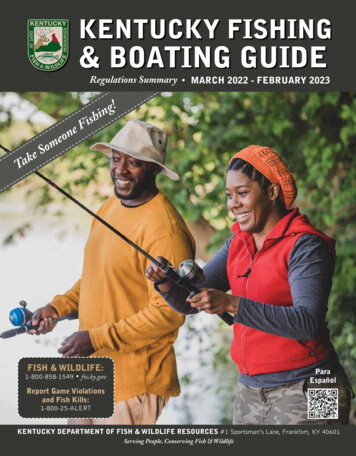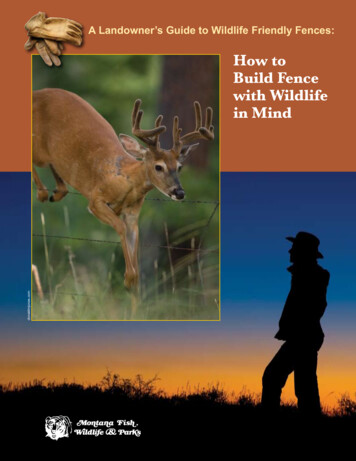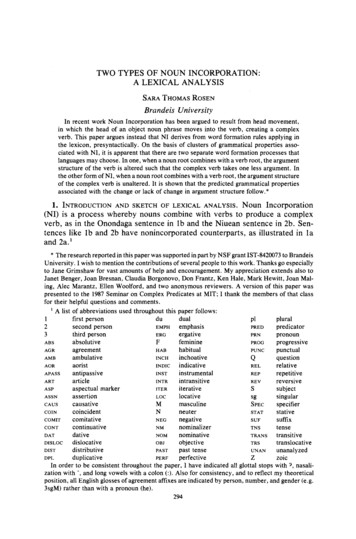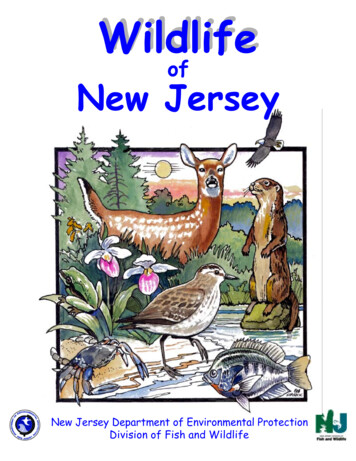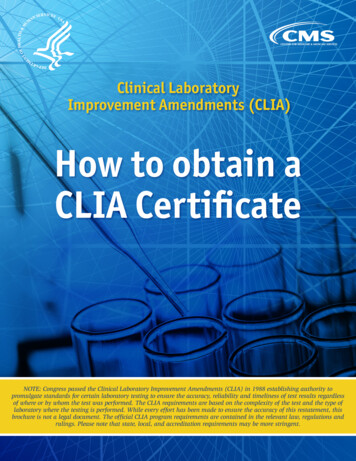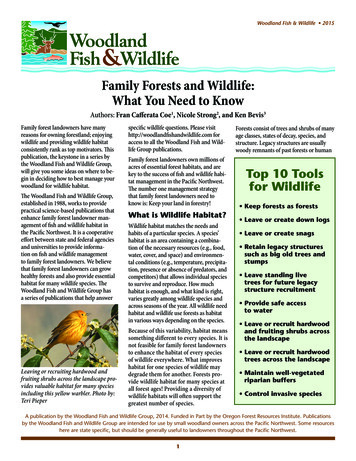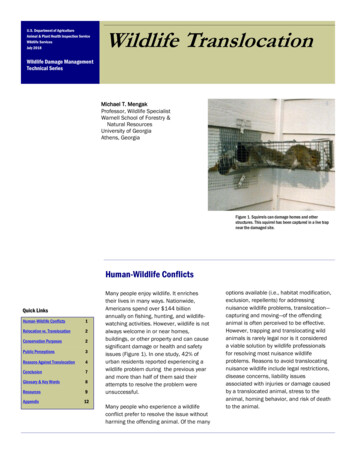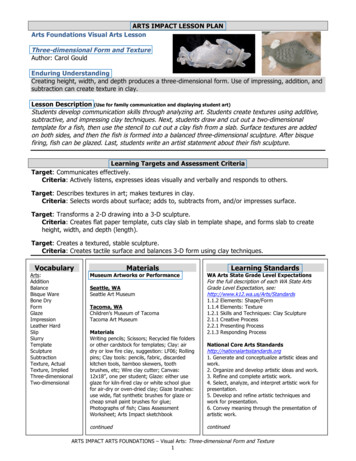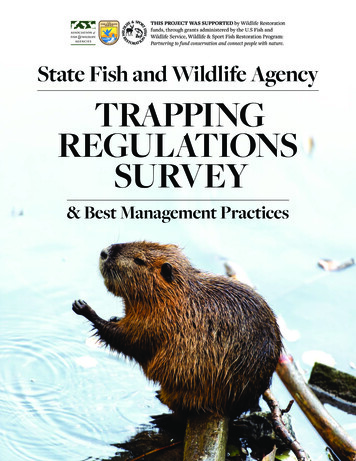
Transcription
State Fish and Wildlife AgencyTRAPPINGREGULATIONSSURVEY& Best Management Practices
IntroductionTRAPPING IS A HEAVILY REGULATEDACTIVITY IN THE UNITED STATESAND REMAINS AN IMPORTANT TOOLfor managing numerous species of wildlifeand habitats, protecting public and privateproperty, protecting endangered andthreatened wildlife and restoring extirpatedand endangered wildlife populations. In acontinuous effort to understand the fullscope and breadth of this activity acrossNorth America, surveys have intermittentlybeen conducted by the Association of Fishand Wildlife Agencies. The annual regulatedharvest of wild furbearers occurs underthe conditions set forth in regulationsKENTUCKY DEPARTMENT OF FISH & WILDLIFE RESOURCESpromulgated within each state. The summaryState Fish and Wildlife agencies strive to educate and recruit youngpeople into outdoor activities, like regulated trapping, to continue theirdata of furbearer trapping regulationsconservation programs.contained in this report were gathered by theAssociation of Fish and Wildlife Agencies during the summer and fall of 2016 in an effort to examine currentlaws for the harvest of 26 species of furbearers by regulated trapping throughout the United States. Responserate to the survey was 100%. To see the full report, visit www.fishwildlife.org.FOCUS ON: LICENSINGAre trappers required to have a license?All states where trapping occurs require a trapping licensefor residents and non-residents. In some states, residentlandowners are not required to have a license whentrapping on their own property. States vary in resident andnon-resident trapper license age thresholds. Most statesrequire anyone ages 12-64 to have a license.How much does a trapping license cost, on average?A resident license is 30. A non-resident license is 200.Do states allow nonresident trapping?48 states allow nonresidents to trap; the one exception,besides Hawaii where no trapping for fur harvest occurs,is Florida. Minnesota is unique in that only nonresidentswho own land in Minnesota may buy a nonresident trappinglicense. With the nonresident license in Minnesota,trappers may only trap on the property they own. In someother states, harvest may be restricted for non-residenttrappers to certain species or quotas, which may not applyto resident trappers.COVER AND ABOVE IMAGES FROM ISTOCKPHOTO2
Trapper EducationBY THE NUMBERSTHE PUBLIC WHO TRAP MUST BE FAMILIAR WITH THE MANY LAWSAND REGULATIONS that govern trapping, as well as animal behavior, wildlifehabitat, types of traps, trap preparation, sets and lures for different animals,and care of pelts. All these elements are taught in state or national trappereducation courses. Trapper educationis available in every state via the NorthAmerican Trapper Education Programdeveloped by the Association of Fish and Wildlife Agencies. This course isavailable online (conservationlearning.org) and via a booklet downloadable atwww.fishwildlife.org. The AFWA curriculum has been incorporated, at least inpart, into 80% of trapper education programs nationally. Fifteen states use thisprogram exclusively and about 45% of the states were aware (at the time of thesurvey) that this program had been unanimously recognized by AFWA memberstates as a reciprocal course for the qualification of state licensing.21States where trappereducation is mandatory forindividual licenses.35States where trappereducation is offeredthrough the state agency ora trapper association.50States where the AFWANorth American TrapperEducation Program isavailable.Best Management PracticesBEST MANAGEMENT PRACTICES (BMPS) ARE BASED ON THE MOST EXTENSIVE STUDY OFANIMAL TRAPS ever conducted in the United States, combining scientific research and professionalexperience related to traps and trapping technology. BMPs are based on five elements or criteria related totrap performance: Animal Welfare, Efficiency, Selectivity, Practicality and Safety. Traps are tested, and if theymeet benchmark criteria related to these performance elements, they are considered BMP traps.BMP traps are divided into two types: lethal devices or live restraining devices. BMPs serve as a frameworkfor identifying and documenting trapping methods and equipment that improve trapping. BMPs are intendedto complement and enhance trapper education programs, providing technical information to help managersand trappers alike to select the best and most appropriate devices. Eighty-five percent of existing U.S. trappereducation programs incorporate BMPs.OVER THE PAST SEVERAL YEARS, HAS YOUR STATE USED BMPs IN MANAGEMENT PROGRAMSOR PROMOTED AND IMPLEMENTED BMPS IN ANY OF THE FOLLOWING WAYS? (TOP 3 RESPONSES)81%At training sessions forexternal audiences (e.g.,NWCO courses, trappers,public)71%Media contacts (interviews,articles, etc.)59%Legislative actions or AgencyCommission actions (useBMP data in talking points forlegislators and commissioners)3
General TrappingTHE FOLLOWING SECTION ADDRESSES OTHERMANAGEMENT PROGRAM INFORMATION of interestto wildlife managers. These include questions on thesale and export of wildlife, dispatch methods, public andprivate lands trapping. Most states require the immediatedispatch or release of furbearers captured alive; however,a few states allow furbearers that are trapped alive to besold as live animals. Coyotes and foxes are the speciesmost commonly allowed, and are restricted only to be soldwithin the state of capture.Trappers make an effort to use all parts of harvestedfurbearers. As such, the sale of furbearer parts (in additionto the fur) such as glands (including castor and skunkessence) urine, skulls, bones and meat is allowed in moststates. A trapping license is required to legally sell these items.ISTOCKPHOTOWHAT TYPES OF TRAPS ARE ALLOWED?*NOTE: Regulations change periodically; verification of existing laws is appropriate before setting traps in each state.STATEBODYGRIPFOOTHOLDSNARECAGE/BOXAlabama Alaska Arizona Arkansas California ColoradoBODYGRIPFOOTHOLDSNARECAGE/BOXMontana Nebraska Nevada New Hampshire New Jersey New Mexico New York North Carolina STATEConnecticut Delaware North Dakota Ohio Idaho Oregon Illinois Pennsylvania Indiana Rhode Island Iowa South Carolina Kansas South Dakota Kentucky Tennessee Louisiana Texas Maine Utah Maryland Vermont Virginia Michigan WashingtonMinnesota West Virginia Mississippi Wisconsin Missouri Wyoming FloridaGeorgiaHawaiiOklahomaMassachusetts *Differences may exist in various states between what is allowed for some traps between: 1) Land and water use 2) Take during regulatedharvest seasons and trapping for human-wildlife conflict resolution, and 3) Whether a device may be set for lethal or live capture.4
Trapping DevicesBODYGRIP TRAPSBodygrip traps are designed to kill an animal quickly when one or two rotating jaws strikean animal’s neck or chest. States regulate when and where bodygrip traps may be used, andthe legality of certain trap jaw spreads.T The use of bodygrip traps is allowed in 43 states. All of these states allow bodygrip trapsto be placed in water sets; 41 states allow the placement of bodygrip traps on dryland.T Of those states that allow the use of bodygrip traps on dryland, some restrict the jawspread and/or require traps of certain sizes to be elevated or in cubbies when on dryland.T The majority of states do not allow the use of bodygrip traps with a jaw spread of 8 inchesor greater on dryland, but rather, such traps must be used in water sets, often partially tofully submerged.T Bodygrip traps set on dryland must generally be checked every day, in the majority ofstates where they are allowed.FOOTHOLD TRAPSFoothold traps are live-restraining traps designed to close on an animal’s foot across, orabove the foot pad, and they may be used on land or water.T The use of foothold traps is allowed in 43 states, with 42 states allowing them to be usedin land sets and 41 states allowing their use in water sets.T Trap check intervals vary among states, but of those states allowing the use of footholdtraps, a daily trap check is most common.T The setting of foothold traps is often restricted by location (to enhance selectivity of thistechnique), and most states have jaw spread restrictions for traps that may be set on dryland.T Some states also require trap jaws to be modified with offset, laminated or padded jawsand have a shock-spring incorporated into the chain.SNARESThe use of snares (any device that consists primarily of a cable and lock used to restrain afurbearer) to capture furbearers is allowed in 40 states. In some, the use of these devices isrestricted to various species: beaver, otter and canids.T Four states require trappers to take a snare-specific class before they may use snares.T 34 states allow the use of snares in land sets. Most states restrict the locations wheresnares may be set.T The majority of states require snares to be checked daily.T Snares may be used for live restraint (often called a cable restraint device) or lethalcapture, depending on the components of the snare and the location of the set.T Snares may be set for live restraint in 33 states; 27 states allow snares as lethal devices.CAGE AND BOX TRAPS49 states allow the use of cage/box traps and often restrict where devices may be placed. Adaily check and removal of captured animals is required in most states. Multi-catch colonytraps are allowed for use on land in 33 states, whereas 39 states allow their use underwater.TRAP ILLUSTRATIONS BY JOE GOODMAN5
ISTOCKPHOTOCAPTURE TECHNIQUES FOR MOUNTAIN LIONS AND BLACK BEARST Twelve states allow the harvest of mountain lions, and of these, 11 allow the capture of lions with trapping devices (mostly forhuman-wildlife conflict resolution).T Two states allow trapping devices (foothold, box/cage/culvert, snares) to be used to harvest mountain lions (New Mexico, Texas).T Thirty-two states allow the regulated harvest of black bears; 9 allow the capture of black bear with trapping devices (mostly forhuman-wildlife conflict resolution). Foothold traps may not be used to capture black bear in any state. The state of Maine allows theregulated harvest of black bears with trapping devices. Only specific foot snares or cage/box/culvert traps may be used, and only onedevice can be deployed at any one time. Bag limit is one bear.FURBEARER HUNTINGT Forty-four states allow the hunting of furbearing animals during night time hours. Forty-two of these states allow the use ofartificial light to assist in the take of animals. Many restrictions apply.T Forty states allow the use of electronic calls for hunting furbearers.T Forty-four states allow dogs to be used in their take. Further regulations are described with the use of dogs.T All 49 states surveyed allow the harvest of furbearers by hunting.About CITESTHE CONVENTION ON INTERNATIONAL TRADE IN ENDANGEREDSPECIES OF WILD FAUNA AND FLORA (CITES) is an internationaltreaty to prevent species from becoming endangered or extinct because ofinternational trade. Under this treaty, countries work together to regulate theinternational trade of animal and plant species and ensure that this trade is notdetrimental to the survival of wild populations. Thanks to conservation effortsby state and federal wildlife agencies, North American river otters and bobcatsare common and abundant in the United States. However, these two speciesare included in Appendix II of CITES due to their similarity of appearance tothreatened and endangered otter and Lynx species in other countries. Beforethe pelt of a North American river otter or bobcat can be exported from theUnited States, a CITES tag must be affixed to the pelt. This CITES tag verifiesthat the animal originated from the United States, which aids custom officersin detecting illegal trade in otter and Lynx species from other countries.HOW HARVESTERSRECEIVE TAGS11Number of states whereCITES tags are mailed by theagency.35Number of states where tagsare applied to the carcass byan agency representative.6States where there are othermethods of tag distribution.6
Science-Based Managementand Conservation ProgramsPROFESSIONAL WILDLIFE BIOLOGISTS MONITOR AND EVALUATE THE STATUS OFFURBEARER POPULATIONS on a regular basis and respond with appropriate management actions.Much of the information known about furbearer populations, and the scientific management of furbearerpopulations, has been derived from information collected through regulated trapping programs.Two key methods used by states to collect data on furbearer populations are mail surveys and carcasscollection. Mail surveys of licensed trappers generally provide information on the annual harvest, presence/absence and range expansion or decline of various species. Carcasses (or parts such as teeth, reproductivetracts, etc.) provide vital information on genetics, diseases, overall health, food habits, reproductive success,heavy metals and contaminant loads, and more.When additional information is needed, more intensive research programs can be initiated. Informationcollected through regulated trapping programs is invaluable, and these data demonstrate how regulatedtrapping has historically contributed to the scientific conservation and management of furbearer populations.MONITORINGDATA COLLECTIONPRACTICES27Number of states thatcurrently collect teeth orcarcasses for biologicalanalysis.23Number of states that haveper-trapper quotas in placefor various species.42KENTUCKY DEPARTMENT OF FISH & WILDLIFE RESOURCESPassing on a heritage of trapping: State Fish and Wildlife agencies rely on informationcollected through regulated trapping to continue their conservation efforts.Number of states that collectinformation to estimate theharvest levels of furbearers,and for most, this includesall furbearers. The primarymethod used is a mail surveyof trappers.7
T The majority of states require snares to be checked daily. T Snares may be used for live restraint (often called a cable restraint device) or lethal capture, depending on the components of the snare and the location of the set. T Snares may be set for live restraint in 33 states; 27 states allow snares

